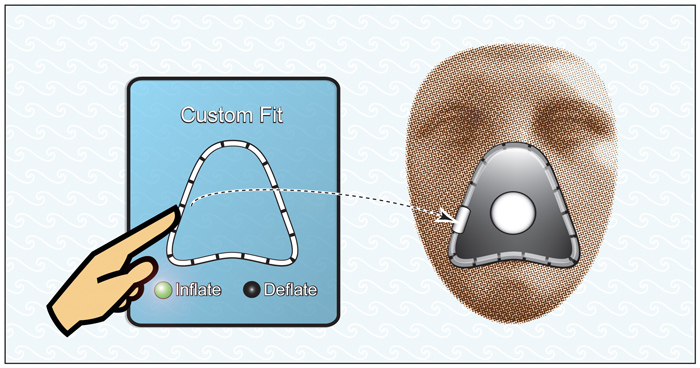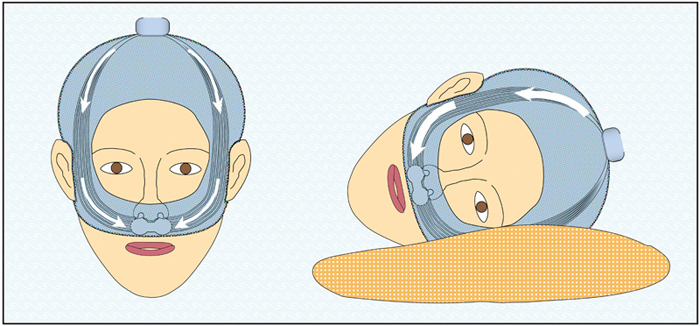Sleepnea: New Therapy
Options
for Obstructive Sleep
Apnea
Sleepnea has a growing intellectual
property portfolio that currently comprises eight pending patents for devices
and methods to treat Obstructive Sleep Apnea. This portfolio includes
new mask technologies to create masks with the potential to be more comfortable,
fit better, leak less, and are less prone to being dislodged by head-to-pillow
interaction than masks that are currently available. Of these patent-pending
mask technologies, the two that are the most developed thus far are the
"Adjustable-Contour Mask" and the "Fabric-Channel Mask." Sleepnea
also has pending patents for non-surgical, non-neurostimulation devices
and methods to keep the tongue out of the airway during sleep.
The first of Sleepnea's more-developed
mask designs is the Adjustable-Contour Mask. This mask has an engaging
user interface that allows a patient to custom fit the mask to their face
while they are wearing it in manner that is not possible with currently-available
masks. Figure 1 below shows one way in which the Adjustable-Contour
Mask may be embodied. The right side of Figure 1 shows a mask with
individually-inflatable compartments around the perimeter of the mask where
it fits again the persons face. The left side of Figure 1 shows a
touch-screen user interface that allows the patient to individually inflate
or deflate each of the compartments around the perimeter of the mask in
order to custom adjust and conform the mask to the contours of their face.
This user-interface enables custom fitting to reduce leaks and tight spots
around the perimeter of the mask.

Figure 1: Adjustable-Contour
Mask
(with Custom-Fitting Touch-Screen
User Interface)
In this example, each of
the inflatable compartments around the perimeter of the mask interface
can be individually inflated or deflated by adjusting the pressure of a
gas within the compartment. The ability to differentially and selectively
adjust the size and/or shape of each of these inflatable compartments by
individually adjusting the pressure within each compartment allows customization
of the shape of the perimeter of the mask to better fit the contours of
an individual's face while the mask is being worn. This helps to
avoid areas of excess pressure (that can cause skin irritation and pain)
and to avoid areas of inadequate pressure (that can cause air leaks).
Having differentially and
selectively movable members around the face-contacting contour (perimeter)
of the mask allows a better and more comfortable seal than is possible
with methods that rely on straps to hold the mask against one's face.
One can adjust the overall position and pressure of a standard respiratory
mask by adjusting straps, but there are limits to how accurately the straps
can change the face-contacting contour of a standard mask. Having
differentially and selectively adjustable members around the perimeter
of the mask also allows a better seal than is possible with a single inflatable
ring or a single compressible gel ring. With a single inflatable
ring, it can be difficult or impossible to find a single inflation pressure
that stops leaks at spots where there is a gap between the mask surface
and face without pinching or overly compressing the skin at other spots.
The second of Sleepnea's
more-developed mask designs is the Fabric-Channel Mask. This mask
has multiple, redundant air channels that are integrated into soft fabric
for greater comfort and reduced leaks, especially for patients who toss
and turn in their sleep. Figure 2 below shows one way in which
a Fabric-Channel Mask may be embodied. In this figure, the
Fabric-Channel mask is embodied in a "ski-mask" design with multiple tubes
woven into, or threaded through fabric channels within, each side of the
mask face.

Figure 2: Fabric-Channel
Mask
(with Multiple, Redundant
Air Channels on Both Sides of the Face)
The left side of Figure 2
shows roughly equal airflow through multiple air channels on both sides
of the face when the mask is worn without any contact with an external
surface such as a pillow. The right side of Figure 2 shows how proper
airflow is maintained by greater airflow through one side of the mask when
the other side of the mask is compressed by contact with an external surface
such as a pillow.
This design with multiple,
redundant air channels allows a more comfortable mask design that accommodates
more tossing, turning, and extensive head-to-pillow interaction than conventional
masks with one central (and relatively-incompressible) air tube.
If the person were wearing a conventional mask with one large tube, then
the mask would be subject to torque force from the pillow and would likely
leak or be dislodged entirely. However, the Fabric-Channel mask with
multiple redundant channels can provide proper air pressure and flow, without
leakage or dislodging, even when a person's face is pressed against a pillow.
In the right side of in Figure
2 with the head pressed against a pillow, airflow through the air channels
on the downward side of the person's face is significantly reduced by compression
of these tubes against the pillow. However, the same total airflow
is maintained by an increase in airflow through the channels on the upward
side of the person's face, away from the pillow. Accommodation
of compression in redundant pathways allows the use of thinner tubes.
The use of thinner tubes can result in a more flexible and comfortable
textile member to deliver pressurized gas. Accordingly, the
Fabric-Channel Mask may be tolerated by many people suffering from obstructive
sleep apnea who cannot tolerate current masks.
Sleepnea has submitted a
Phase I SBIR grant to NIH for funding to prototype and benchtest these
two novel mask designs. Research milestones for the Adjustable-Contour
Mask include achieving 50% reduction in mask leakage and facial pressure
variation as compared to currently-available masks. Research milestones
for the Fabric-Channel Mask include maintenance of therapeutic values of
air pressure and flow and 50% reduction in mask leakage and facial pressure
variation as compared to currently-available masks, including maintenance
of air pressure and flow during simulated torque forces and head-to-pillow
interaction.
Sleepnea also has several
pending patents for novel non-surgical, non-neurostimulation devices and
methods to: keep the tongue out of the airway during sleep; and move the
tongue forward out of the airway if it slips backwards during sleep.
The details of these pending patents are not disclosed in this website
at this time, but those interested in learning more are encouraged to contact
Sleepnea for more information. |